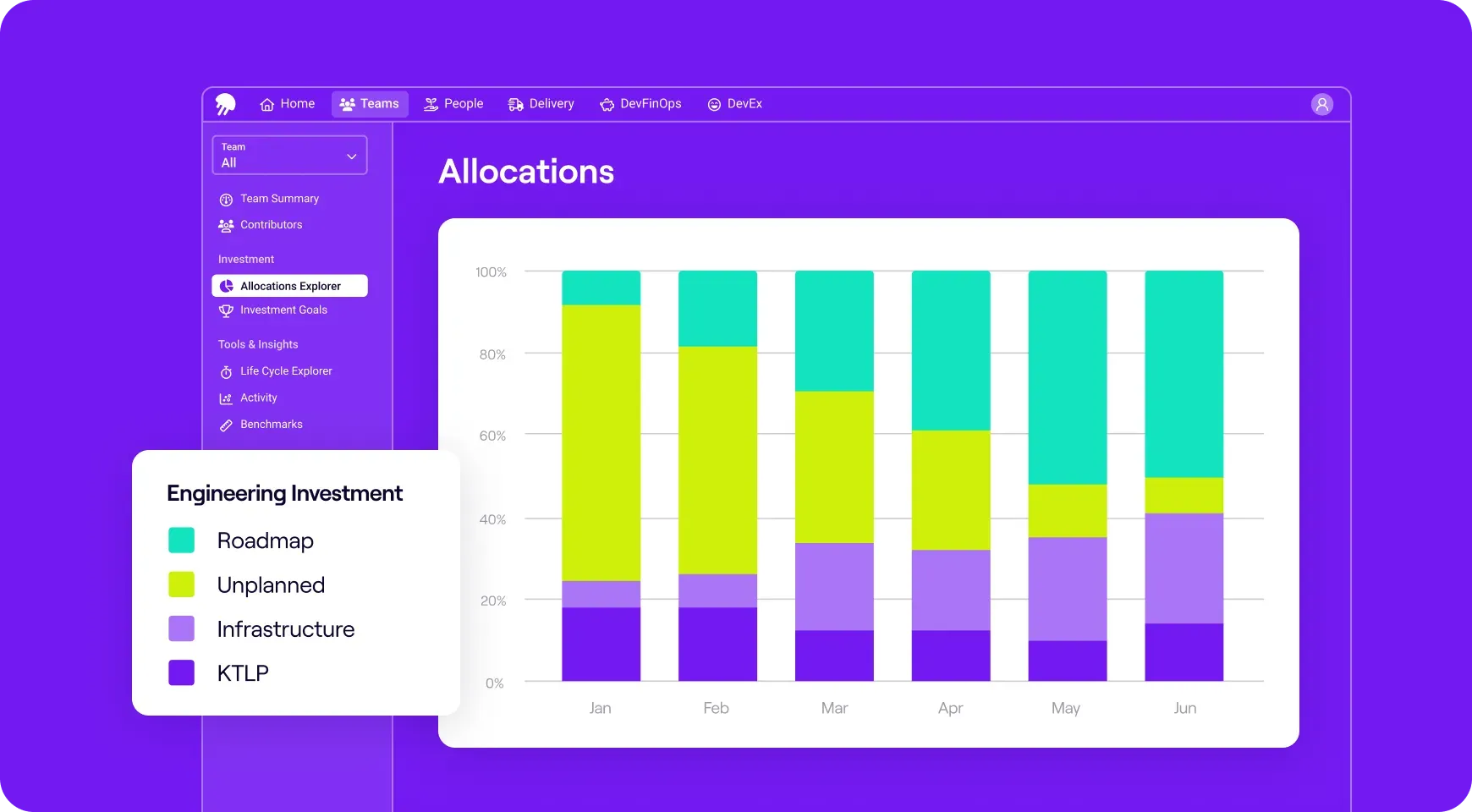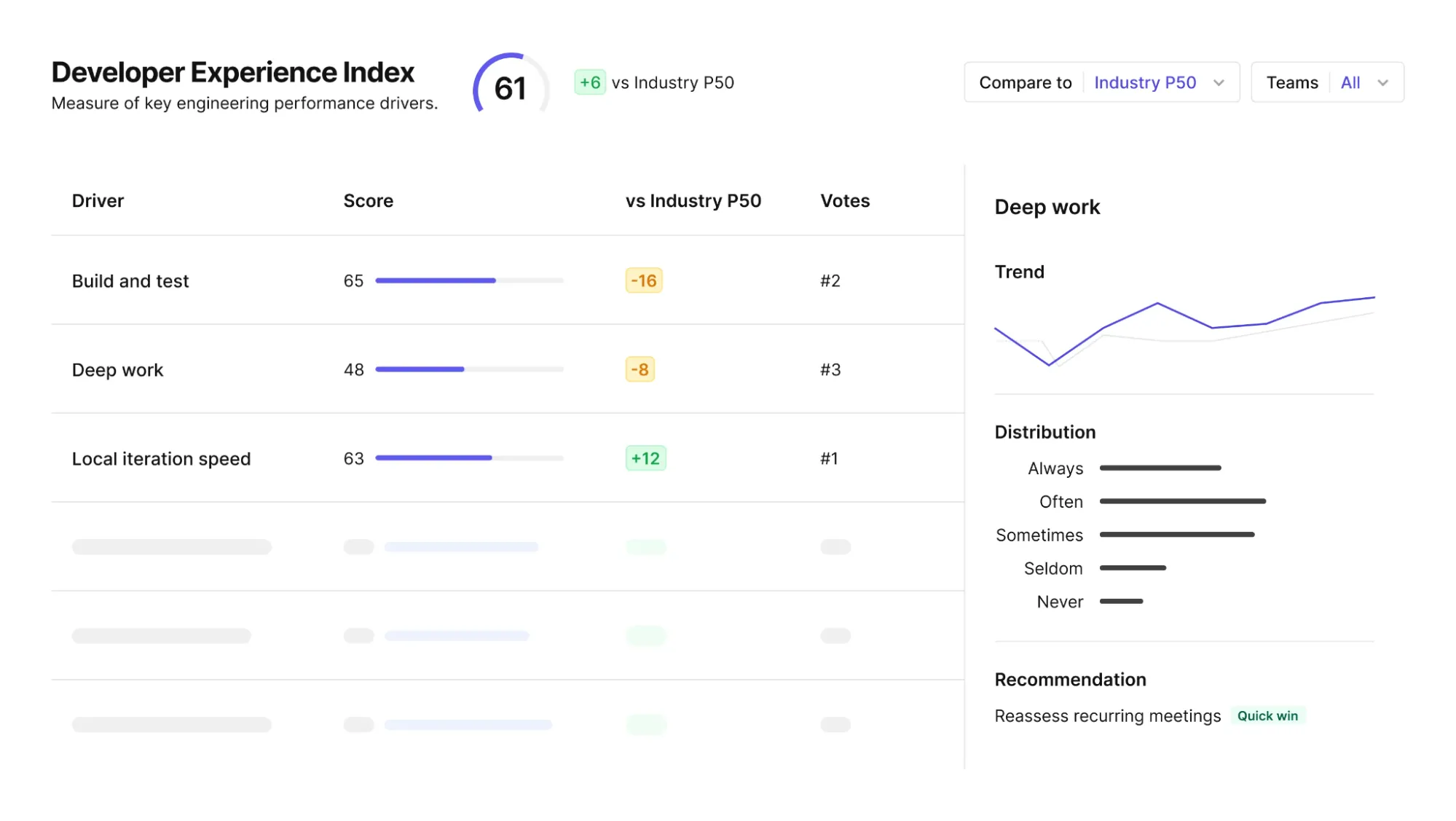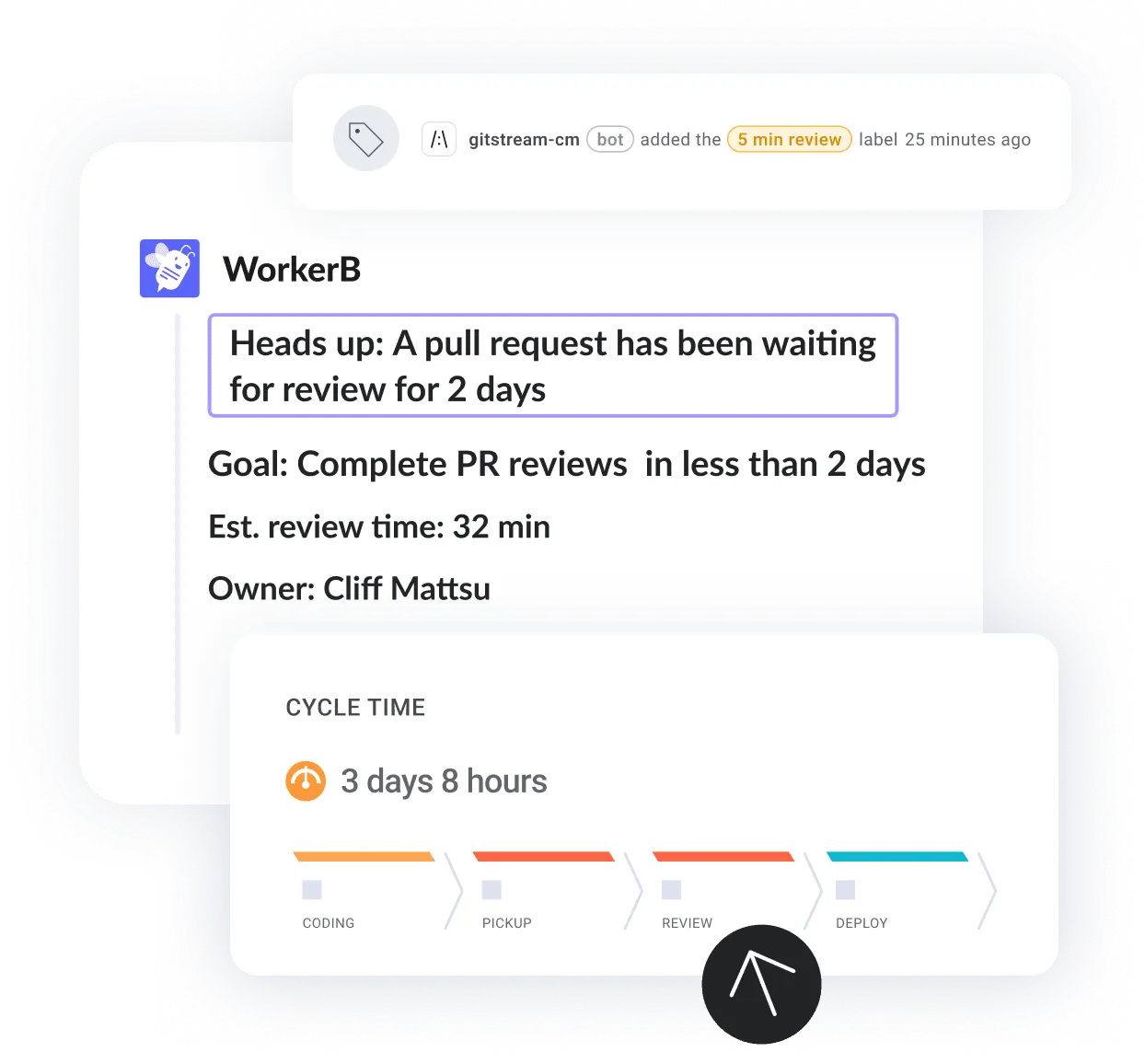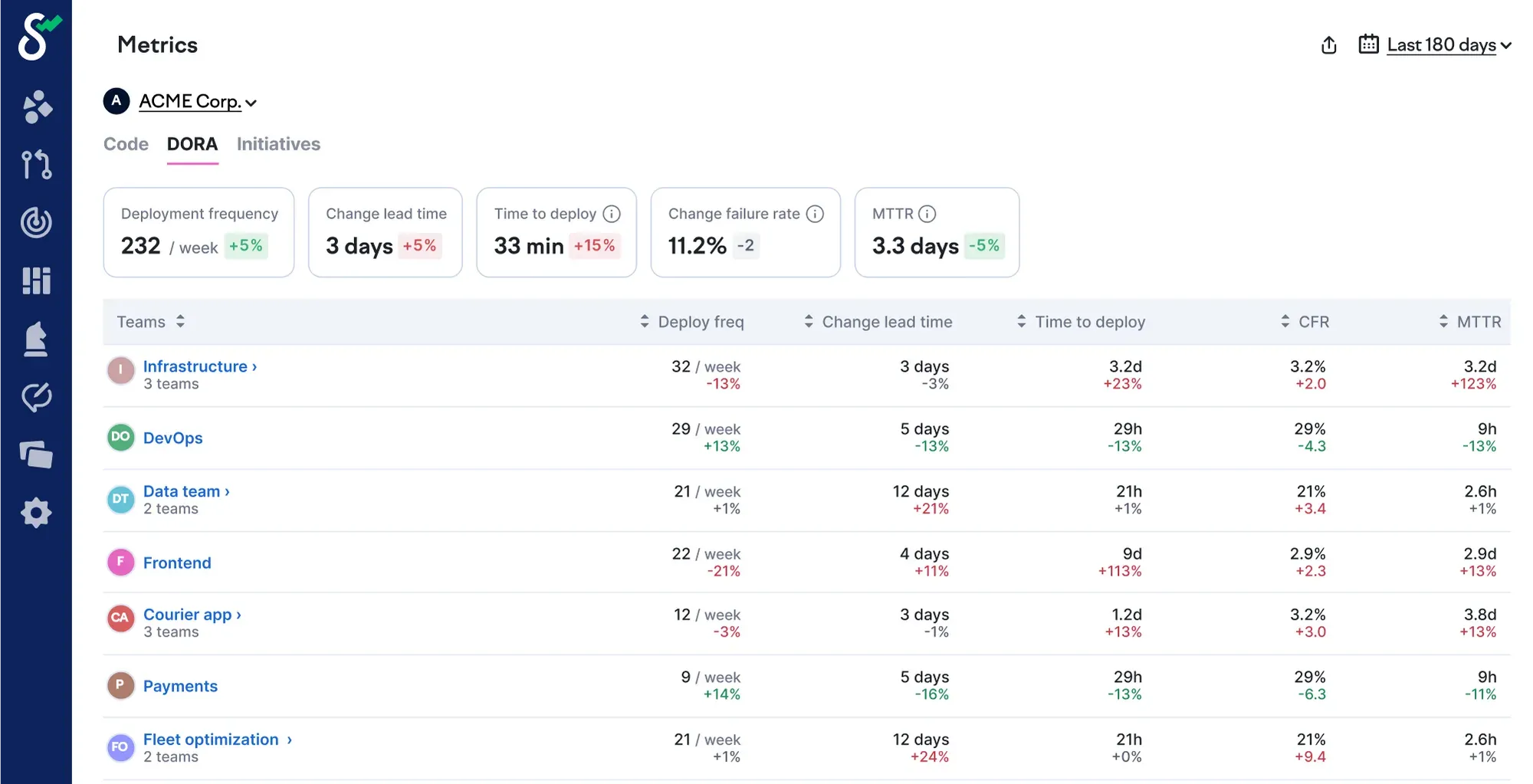Best Allstacks Alternatives: Tools That Align Engineering and Business
Compare top Allstacks alternatives to align your engineering and business goals.

You’re here because you care about what’s holding your engineering team back. Maybe you’ve tried Allstacks, or maybe you’ve just heard the name. Either way, something’s not clicking, and you're ready for a smarter way to track progress, manage delivery, and actually understand what’s going on inside your team.
In this article, you’ll get a closer look at 9 powerful Allstacks alternatives that are reshaping how software engineering teams manage delivery, track progress, and make smarter decisions.
Here, you won’t just see a list of tools. You’ll walk away knowing which ones actually help you move faster, align with your business goals, and give you real-time insights you can use.
Before you decide, here’s a quick comparison table to help you see how each platform stacks up.

Alright, before we go any further, let’s get clear on what Allstacks actually does.
What Is Allstacks?
Allstacks is a value stream intelligence platform that helps you monitor engineering performance across your tool stack. You get predictive analytics based on historical data, so you can track progress and spot risks early. It pulls data from tools such as GitHub and Jira Software, then turns it into visual reports to show how work is moving.
If you're leading a growing team, Allstacks helps you measure software delivery performance and align your engineering work with business goals.
That’s critical when you consider the benchmarks. According to the 2024 DORA report, elite teams deploy multiple times per day and recover from failures in under an hour, while low performers take one to six months per change and need up to a month to recover. Tools like Allstacks aim to close the gap between those elite performers and the rest of the pack.
Still, while it’s strong for tracking, some users find the sheer number of metrics overwhelming. And if financial visibility is a must-have, Allstacks might leave you wanting more.
So, let’s talk more about where this tool falls short and why you might want something better.
Why Look for an Allstacks Alternative?
If you’ve used Allstacks or at least watched the demo above, you already know it’s built to analyze engineering performance. But it doesn’t always deliver what growing teams really need. Here are the main reasons you might want something better:
- Allstacks leans heavily on value stream intelligence and machine learning forecasts, but it lacks financial planning features, time tracking, and support for R&D cost insights. It can, instead, gauge time based on how people use their tools daily.
- As an engineering leader, you need tools that bring together strategic planning, delivery visibility, and financial clarity, not just development metrics. While Allstacks recently added a way to calculate Capitalization from their Investment Hours algorithm, this may not be enough for you.
- It also doesn’t offer managed cloud services or compliance-ready infrastructure, which can slow teams down when scaling or preparing for audits.
- Some teams say the dashboards feel scattered and disconnected from key business objectives such as ROI or engineering efficiency.
- If your team is expanding, you probably want a platform that links engineering activity directly to business results, cuts down on manual updates, and works across departments.
- Allstacks gives you every metric and lets you pick what matters. That sounds flexible, but it typically leads to noise instead of actionable insights. Teams often end up spending time configuring dashboards and managing tool connections manually, time that could be better spent on delivery and strategy.
If you’re running into these issues, it’s probably time to look elsewhere. That brings us to the next thing you need to figure out, which is what you should actually look for in a smarter alternative.
What to Look for in an Allstacks Alternative
If you're choosing a new platform, you're probably looking for more than just graphs. You want clarity, speed, and tools that actually help you lead better. Here are the features that matter most when replacing Allstacks:
- Real-time project tracking: Allstacks does offer real-time KPI tracking through its customizable dashboards and performance metrics features. If you’re looking for an alternative, you want it to show where work stands right now, not just in last week’s report.
- Resource allocation insights: Know how your team’s time and energy are being spent across projects. Data categorization is pretty important, too.
- Financial performance monitoring: Track budget use, catch overruns early, and understand the true ROI of your R&D efforts.
- Business alignment metrics: Connect engineering output to your strategic objectives and OKRs.
- Proactive risk identification: Catch blockers and slowdowns before they snowball.
- Developer productivity signals: Understand focus time, context switching, and code reviews without guessing.
- Automated reporting & executive dashboards: Share clear updates with leadership instantly, without spending hours pulling data or building slides.
You need more than a basic analytics tool. You need powerful insights, continuous improvement, and complete visibility across your entire software development lifecycle. With that in mind, let's talk about the 9 best Allstacks alternatives that offer stronger features for modern engineering teams.
The 6 Best Allstacks Alternatives in 2025
If Allstacks isn’t giving you the clarity or control you need, you’ve got better options. Here are 6 good alternatives for 2025 to help you lead smarter, cut developer friction, and turn your data into valuable insights that actually guide decisions.
1. Chrono Platform
Chrono Platform gives you real-time visibility across your engineering projects, finances, and resources. You don’t just track time here. You also get retroactive time categorization, which means if your R&D priorities shift, your time data can shift with them. That’s ideal for teams claiming SR&ED or managing cost-based KPIs.
With Chrono, you get a 360-degree view of your software development process. You’ll know where your engineering hours go, how much of it is tied to strategic goals, and how that time turns into business outcomes. The platform connects to Jira, Google Calendar, Outlook, and more without replacing them. You can still plan in Jira, but you actually understand the output with Chrono.

If you’re growing fast and need on-demand hiring help or cost justification for your CFO, Chrono also includes capacity planning and hiring support. Plus, its infrastructure is SOC2- and ISO-ready, with DevOps support options for AWS, Azure, and GCP.
Pros:
- Auto and retroactive time categorization
- Audit-ready financial visibility and SR&ED tagging
- Capacity insights to help you scale or hire
- Real-time insights that align with both engineering and finance
- Complements Jira, doesn’t try to replace it
- SOC2/ISO-ready infrastructure with optional managed DevOps
- Not focused on individual productivity metrics such as code reviews or pull requests
Cons:
- Not best for developer-level metrics
Best for: Scaling teams needing business-aligned engineering decisions.
Website: https://www.chronoplatform.com/
Price plans:
- Free Plan: $0/user/month, for up to 3 users
- Team Plan: $15/user/month
- Pro Plan: $25/user/month
- Enterprise Plan: Contact for pricing, for 50+ users
Service subscriptions (add-ons):
- Talent (Engineer-led hiring support): $350/month + 7% commission on base salary
- Managed DevOps: From $1,150/month
- Capacity On-Demand (Fully managed full-stack teams): $35,000/month
2. Jellyfish
If you're trying to align engineering with broader business goals, Jellyfish might catch your attention. You’ll get visibility into resource allocation and strategic alignment, which is helpful if you’re managing cross-functional priorities.

Jellyfish gives you solid dashboards to measure software delivery performance, but don’t expect much real-time data. It’s built more for high-level planning than fast decision-making.
The platform shines in large environments where you need to track budget usage, team focus, and initiative progress. It also has dedicated onboarding teams to help. But if you're hoping for deep documentation, it may leave you figuring things out on your own.
Compared to Allstacks, Jellyfish leans more into strategic alignment and budget tracking, while Allstacks focuses heavily on value stream metrics and machine learning forecasts for delivery risk and performance. Both tools help at the engineering leadership level, but Jellyfish lacks self-serve flexibility. Teams usually rely on its dedicated onboarding or vendor support to configure dashboards and processes.
Pros:
- Strong resource allocation insights
- Supports strategic decisions with data-driven insights
- Integrates well with popular development tools
- Hands-on onboarding guide
Cons:
- Weak documentation
- Lacks real-time reporting features
Best for: Mid-to-large organizations focused on cross-team alignment.
Website: https://jellyfish.co
Price plan: Custom pricing (contact sales)
3. DX
DX takes a people-first approach to engineering analytics. Instead of just tracking metrics such as deployment frequency or lines of code, you get a full picture of how your developers feel and function. It blends platform data with developer self-reporting to measure team health, satisfaction, and productivity.
However, it also allows you to compare your results with industry benchmarks.

If you care about building a stronger culture, not just faster output, DX gives you the frameworks to do it. The proprietary DXI and Core 4 models let you dig into areas such as autonomy, clarity, and flow.
On the other hand, it lacks financial performance monitoring, proactive risk identification, and engineering operational efficiency.
Pros:
- Combines system metrics with developer feedback
- Strong focus on culture, satisfaction, and retention
Cons:
- No deep analytics for code, R&D, or finances
- Lacks engineering-business alignment
- Limited Azure DevOps support
Best for: Engineering organizations focused on a productivity culture.
Website: https://getdx.com
Price plan: Custom pricing (contact sales)
4. LinearB
LinearB helps you stay on top of your Git pipeline by tracking delivery metrics and automating workflows. You can measure metrics like deployment frequency, lead time, and PR cycle times while getting real-time suggestions to speed things up. This tool works best if your team lives in Git and relies on automation to reduce manual work.

But it’s not without issues. LinearB simplifies incident management too much by tying it almost entirely to tools such as Jira, which doesn’t give you the full picture. It also clones your entire repository to analyze data, which can raise serious security concerns depending on your setup.
If your team is DevOps-heavy and you’re looking to remove bottlenecks and move faster through Git-based automation, this could be a useful fit. However, it lacks engineering ROI intelligence and other features where Chrono Platform shines.
Pros:
- Strong Git-based insights
- Workflow automation that saves time
- Includes DORA and developer performance metrics
Cons:
- Incident management is overly simplified and tied almost entirely to issue trackers like Jira
- Clones entire repositories for analysis, which can raise serious security concerns
- No engineering ROI intelligence
Best for: DevOps-heavy teams wanting automation insights.
Website: https://linearb.io
Price plans:
- Business: $49/month per contributor
- Enterprise: Custom pricing with extras such as SSO and on-prem support
5. Code Climate Velocity
Code Climate Velocity gives you a basic but clear view of engineering output by tracking pull requests, commits, and ticket progress. It’s typically used for performance tracking and helps you understand where your team spends time, how fast they ship, and who might need support.
Code Climate’s unique selling point is its GitHub Copilot. This tool automatically translates raw Git and project management data into actionable engineering health metrics. The goal is to surface risks like slow reviews or excessive WIP early, so leaders can coach teams and fine-tune workflows before problems hit delivery.

Code Climate includes customizable dashboards for visualizing activity, though you may find the reporting options a bit limited if you're trying to track custom workflows or compare sprint cycles.
The platform’s focus on software delivery processes makes it helpful for productivity coaching, but not for deeper financial or operational analytics. Some users have also raised concerns about its approach to repo access for metric calculation.
Compared to Chrono, Code Climate Velocity lacks some important features for engineering leaders, such as automated SR&ED, intelligent talent matching, or managed Cloud services.
Pros:
- Provides clear team contribution insights
- Helpful for performance management and coaching
- Customizable dashboards for basic tracking
Cons:
- Simplistic incident handling
- Clones entire repos, which can raise security concerns
- Lacks essential features for engineering leaders
Best for: Teams seeking basic engineering output tracking.
Website: https://codeclimate.com
Price plans:
- Open source: $0
- Startup: $0 (up to 4 seats)
- Team: $16.67/ month/ seat (billed annually)
6. Swarmia
Swarmia positions itself as a developer-centric effectiveness platform, surfacing real-time DORA and SPACE metrics, CI and PR cycle-time insights, batch size tracking, and even developer experience surveys for a rounded view of delivery health.

Just like Allstacks, it has a self-serve setup for dashboarding and tooling, which is great for teams wanting control over metrics.
Allstacks is more focused on value-stream forecasts and machine-learning risk models. By comparison, Swarmia excels at speeding up team-level flow and surfacing blockers through live Slack signals and working agreements. Also, it offers more granular, real-time data, with no 24-hour delay.
However, Swarmia isn’t perfect. It doesn’t offer big-picture finance or R&D cost visibility, and it lacks features like automated SR&ED readiness or talent-matching tools that engineering execs might need at scale.
Pros:
- Real-time delivery metrics with Slack hooks and working agreements
- Out-of-the-box DORA/SPACE compliance with minimal configuration
- Self-serve dashboarding and survey tools
Cons:
- No built-in financial tracking or SR&ED tagging
- Lacks support for managed cloud setups or squad-level talent alignment
Best for: Engineering teams focused on optimizing flow, developer experience, and daily delivery speed
Website: https://www.swarmia.com/
Price plans:
- Free: $0 (for maximum 9 developers)
- Standard: $45/ developer/ month
- Enterprise: Upon request
Final Thoughts: Choosing the Right Platform for Your Engineering Org
After reviewing these six Allstacks alternatives, one thing is clear: you need something that actually works for you. So, make sure the platform you settle on has real data you can use, with the integration depth and strategic reporting your team needs to grow. If you're scaling fast, Chrono helps you prove value and stay aligned across delivery and finance.
Skip the noise and go for a platform built for engineering leaders like you.
Chrono gives you real-time visibility into your engineering work and its impact on your bottom line.

If your CFO cares about ROI, we help you track it. You won’t be stuck explaining vanity metrics, because Chrono shows what matters.
Ready to move faster and make smarter decisions? Sign up for Chrono Platform and let’s get to work.
FAQ
What are the top Allstacks competitors?
You’ve got strong choices, but if you’re looking for clarity, alignment, and ROI tracking in one place, Chrono Platform stands out. Other options, such as Jellyfish, DX, and LinearB, offer different slices of software engineering intelligence, but none bring delivery and finance together the way Chrono does.
Are there any free tools like Allstacks for engineering analytics?
Yes, Chrono Platform offers a free plan for up to 3 users. That gives you access to real data, not just high-level summaries. You can start small, test what matters, and scale when you're ready.
Which Allstacks competitor is best suited for startups or small teams?
Chrono is a smart pick here, too. You get real-time engineering visibility and cost tracking without the clutter. Plus, it's easy to use and grows with you as your team scales.
What’s the best Allstacks alternative for large-scale enterprises?
If you’re leading a larger team, Chrono gives you strategic insight into both engineering output and financial performance. From custom metrics to resource planning, it's built to support growth and executive decisions.
What are the leading cloud-based tools for engineering visibility beyond Allstacks?
Chrono Platform, DX, Jellyfish, and LinearB all offer full cloud-based access. They’re reliable, scalable, and integrate with your project management tool stack.
Do Allstacks alternatives offer mobile access or app support?
Yes, Chrono Platform offers a responsive, mobile-friendly experience. You can track what matters, even on the go.
What’s the difference between Allstacks and Chrono?
Allstacks leans into value stream forecasting. Chrono goes deeper into actual time usage, business alignment, and 360-degree visibility with fewer vanity metrics and clearer business signals.
Is Chrono better than Allstacks for CTOs and CPOs?
If you care about outcomes tied to strategy, then yes. Chrono gives you additional insights across delivery, cost, and hiring, without drowning you in data that doesn’t move the needle.



